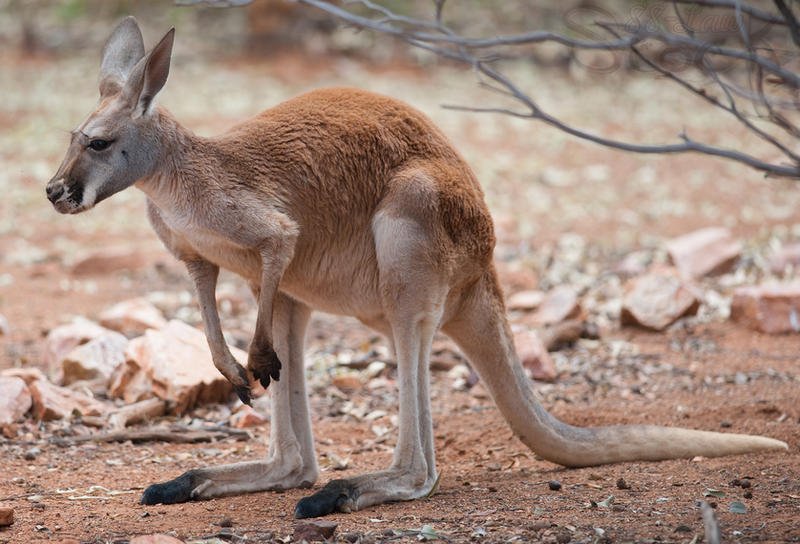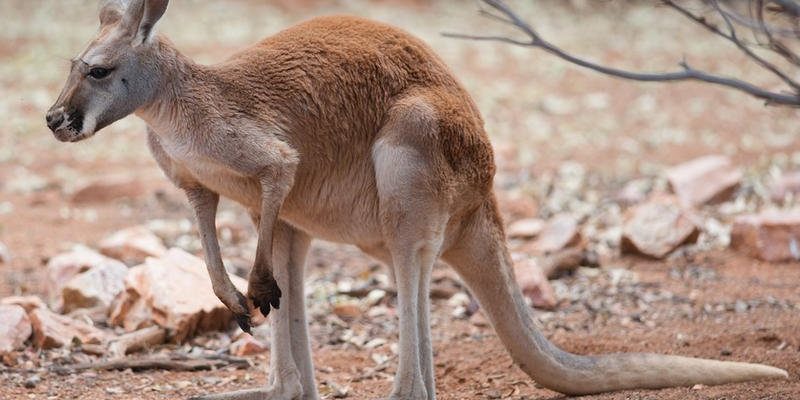
Imagine a mother kangaroo as a dedicated caretaker in this wild, open landscape. The way they raise their young can be likened to a delicate balancing act. On one hand, the mother needs to ensure her joey is protected from predators and harsh environmental conditions. On the other hand, she must prepare her little one for independence. In this guide, we’ll hop into the intricate world of red kangaroo parenting and explore how these remarkable animals nurture their young into the big, bold kangaroos they’re meant to be.
The Life Cycle of a Red Kangaroo
Understanding how red kangaroos raise their young starts with knowing their life cycle. A red kangaroo’s journey begins with mating, typically occurring in late summer, when the weather is warm and food is more abundant. After a gestation period of just 30 to 36 days—shorter than your average dog!—the mother gives birth to a tiny, underdeveloped joey, about the size of a grape.
Once born, the joey instinctively climbs up into the mother’s pouch. This pouch acts like a protective nursery, where the joey attaches to a teat and continues to develop. Here, it’s safe and can suckle for nourishment. This pouch phase can last for several months, with the joey growing and gaining strength while snug inside. It’s incredible how nurturing the pouch phase is, acting almost like a mobile incubator, allowing the baby to develop in a secure environment until it’s ready to venture outside.
From Pouch to Independence
As the joey grows, it will start to peek out of the pouch, curious about the outside world. This phase is crucial as it transitions from total dependency to a bit of independence. You might wonder, how does a mother kangaroo know when to encourage this leap?
The mother kangaroo is quite intuitive. She’ll often let the joey out for short periods, allowing it to experience the surroundings while still being able to retreat to the safety of the pouch if needed. During this time, the joey will begin to nibble on grass and other vegetation, learning what foods are safe to eat. It’s a bit like introducing a toddler to new foods—there’s trial and error, but eventually, they learn what they like.
Listening to their mother’s cues is vital. If the mother senses danger, she’ll pull the joey back into the pouch, demonstrating her protective instinct. This bond between mother and joey is strong during this phase, ensuring the little one learns to adapt while still being closely cared for.
Learning through Play and Exploration
Red kangaroo joeys don’t just sit back and relax; they’re curious little creatures! Once they start coming out of the pouch regularly, they engage in play—often with their siblings or other young kangaroos. This playful interaction is essential for their social development.
Think of it like a toddler’s playground. Through play, joeys learn crucial skills like balancing, hopping, and even basic social interactions. They learn to communicate with each other through various vocalizations and body language, which is vital for their future interactions with other kangaroos.
Moreover, this playful exploration helps strengthen their muscles and coordination. It’s fascinating to watch how they mimic adult kangaroo behaviors, honing their skills for when they eventually leave their mothers for good. The playful learning environment not only fosters independence but also builds confidence in young kangaroos.
Feeding and Foraging Skills
Once the joey starts venturing out, it’s time for some serious learning—specifically, about food. Red kangaroos are herbivores, primarily eating grasses, leaves, and shoots. As they get older, joeys will watch their mothers closely to learn where to find the tastiest food and how to graze effectively.
The mother kangaroo plays a key role in teaching these foraging skills. She’ll often lead her joey to rich feeding grounds, demonstrating what to eat. In the wild, finding food is more than just a snack—it’s about survival. The joey must learn to navigate the terrain and avoid potential dangers like predators.
As they grow, joeys gradually transition to independent feeding. They might still return to the pouch for comfort and safety, but their dependence on the mother for food diminishes. This careful learning process is what helps young red kangaroos thrive in the challenging environment of the Australian outback.
The Importance of Mothering in the Outback
The red kangaroo’s maternal care goes beyond just physical feeding and protection. In the harsh environment of the Australian outback, every little lesson from the mother is crucial. Survival isn’t just about eating; it’s about understanding the surroundings, including potential threats and safe havens.
For example, mother kangaroos often teach their young about the best places to find shelter from the scorching sun or rain. They will lead their young to areas with plenty of vegetation, providing shade and protection. This knowledge is something that helps young kangaroos adapt as they grow older and begin to explore more independently.
Additionally, the bond formed between a mother kangaroo and her joey can influence the young one’s behavior as an adult. A well-adjusted joey is likely to develop social habits that will help it thrive in a larger group. In this regard, mothering is more than just raising—it’s about building a foundation for a successful life in the wild.
Challenges in Raising Young Kangaroos
While red kangaroos are adept at raising their young, they do face numerous challenges. One of the most significant threats is habitat loss due to human activities. As urban areas expand, red kangaroos find it harder to locate safe spaces for raising their young. This can lead to increased stress and competition for resources.
Additionally, environmental factors, such as droughts, can severely impact food availability. When food becomes scarce, mothers may struggle to provide for their joeys, putting additional stress on the family. This is particularly concerning during critical growth phases, where a joey’s nutrition directly affects its development and future survival skills.
Moreover, predation by animals like wild dogs and eagles can pose a threat to young kangaroos. The mother kangaroo’s protective instincts are essential during these times, but there are limits to what she can do against a determined predator. Watching over her young while also ensuring her own survival becomes a challenging balance.
Raising young red kangaroos in the wild is a complex and fascinating process. From the initial days in the pouch to learning crucial life skills through play and exploration, these kangaroos exemplify the quirks and wonders of nature. By understanding these nurturing practices, we can appreciate the deep bond between mother kangaroos and their joeys.
The journey of a red kangaroo from pouch to independence isn’t just about survival; it’s about learning the ropes of life in the wild, ensuring the next generation is equipped to thrive. As these incredible animals navigate the challenges of the Australian outback, their diligent parenting serves as a reminder of the resilience and beauty of wildlife. So, the next time you think of kangaroos, remember the heartwarming—yet tough—journey that leads to each new generation’s leap into the wild.

